
Every March I’d drive west from the Roaring Fork Valley in Colorado, up to the massive Island in the Sky in Canyonlands National Park. Driving up there on Utah 313 I felt like a fly climbing a whale’s back. Standing at the Green River Overlook, the cold wind blowing through my face, I’d stare at the white-rimmed shoulders of red rock looming above the Green River. It was a pilgrimage, a holy site, a silent breaking through into rough, open space.
This was in the late 1980s, when I worked in an upscale drug and alcohol treatment center overlooking Aspen, beneath the Buttermilk Mountain ski slope. It was in a rambling, gray house up a long, graded driveway above Maroon Creek and was an unorthodox, energetic place. A red fox hung out on the steep, wooded bank fronting the creek. One day on an Aspen sidewalk I walked right by columnist George Will.
Somehow he didn’t recognize me.
In April, 2007, I went back to Moab. On our first morning, up on the Island in the Sky, Gail and I stood at the Grand View Point Overlook, studying the single file of spires and steep, sharp-sided buttes down in Monument Basin: the latter’s three terminus canyons eroded into the table of the White Rim like three curving fingers on a Gray alien’s hand. At Shafer Canyon Overlook a shaft of sunlight lit the leading blade of a mesa, its edge plummeting to the canyon floor. Beneath the rock rim of the overlook the switchbacks of the Shafer Canyon Trail curved down at severe angles, before striking out through the canyon in a thin, dust-colored line.
All these gruesomely beautiful views on the Island in the Sky, what people travel from all over the world to see, were as vivid as ever. But the gigantic vibrancy I’d always known up there, the whale’s back in the wilderness, was gone.
A couple of days later, almost as an afterthought, we drove early through the empty streets of Green River and found the turnoff to the Horseshoe Canyon Unit, an isolated fragment of the Park lying west of the main body. A well-graded dirt road led 50 miles south, running straight or gently curving until it vanished into the horizon, through largely flat, spread-out terrain with no recreational designation.
An insignificant place compared with the Island in the Sky.
Here and there as we drove we saw small, red and white layered badlands streaking the landscape. Rust-colored outcrops of sandstone curved down subtle ridges above burnt-orange, sand-covered slopes, stippled with brittlebushes. To the west across a vast expanse of Blackbrush lay a remote desert mountain range covered by snow as surreal as a layer of cotton. The hulking mesa north of Green River stood behind us like a supernatural purple freighter.
Half an hour down the road I felt the shift into solitude. What hadn’t happened at the Island in the Sky.
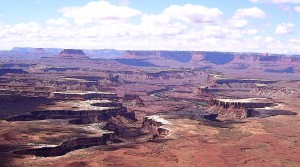
***
While it’s elusive to describe, we can say that solitude is a spiritual bond with the landscape, typically occurring in wild, isolated country, usually when a person is alone but sometimes in the company of one or two trusted people. In the history of our species the phenomenon goes back many, many thousands of years, and was considered fundamental to human spirituality and well being at least until agriculture became dominant. Its robust significance is still appreciated in cohesive indigenous cultures.
What follows is a plausible description, if there is such a thing, by Kathleen Norris, a writer who moved from New York City back to her tiny hamlet of Lemmon in isolated northwest South Dakota: “The silence of the Plains, this great unpeopled landscape of earth and sky, is much like the silence one finds in a monastery, an unfathomable silence that has the power to re-form you. And the Plains have changed me. I was a New Yorker for nearly six years and still love to visit my friends in the city. But now I am conscious of carrying a Plains silence within me into cities, and of carrying my city experiences back to the Plains so that they may be absorbed again back into silence…
…
“Among the simple pleasures of Dakota is driving where there’s no traffic. One moonlit night late in the fall, my husband and I left Rapid City and traveled the two hundred miles home seeing fewer than fifteen vehicles and well over a hundred antelope. Most days I take a long walk at sunrise, and sometimes I’m greeted with a spectacular moonrise as well, the western horizon on fire. There’s no sound to speak of except for wind and birdsong. I can hear a car coming from miles away.” (Dakota, pp. 15, 35-36.)
It’s possible, though less common, for solitude to go beyond bonding with the landscape to a life-altering experience of non-separation, which Edward Abbey had as a young man and many years later struggled to describe to his old pal Jack Loeffler: “…there was a time back in Death Valley where I had what I guess was as close to a mystical experience as I’ve ever had. That was years ago. I was a young man. I’ve never had anything quite like it since. As close as I’ve come is after I’ve been out camping somewhere for at least two weeks. It takes at least that long for me to really get into it and leave all the baggage behind.
…
“Well, it’s not something that’s easy to remember intellectually. It was more the way I felt. As I recall, I felt like I wasn’t separated from anything else. I was by myself at the time. It was as if I could perceive some fundamental activity taking place all around me. Everything was alive. Even the rocks. I was part of it. Not separate from it at all. I wept for joy or something akin to joy that I can’t really describe. It was a long time ago. It’s not something that can be remembered in the normal way. Or at least normal for me. The only time I can get close to it is out camping. I don’t get to do that enough. Not nearly enough.
…
“…In a way, that was one of the most important experiences of my life so far. I’ve tried to get back to it, but I don’t know how….” (Adventures With Ed, pp. 242-243.)
***
For the vast majority of humanity’s history the experience of solitude was an integral part of life. Everyone had ready access to isolated, wild areas; it was an elegantly simple connection. Solitude fostered a universal and unquestioned love for the landscape and the critters that lived upon it.
The situation today is reversed. Within the mainstream society the experience of solitude is well understood by a minute percentage of the public, and also by traditionalists within Native American cultures (so glad they’re around). Within the former this includes people who have gone far enough out on the land for it to come alive for them, and also many of those who are rooted in deeply rural or frontier communities, provided they haven’t become financially dependent on tearing the land apart.
I also suspect that people who live in monasteries often taste solitude, as Kathleen Norris suggested, as well as others who meditate diligently and long – both processes seem to deepen sensitivity to the natural world. One reason I included Edward Abbey’s experience is that it sounds similar to spiritual openings that can occur in week-long Zen meditation retreats, typically after several days of intensive meditation.
Maybe it’s also helpful to grow up surrounded by woods or other open country, as Jim Stiles has said. I was fortunate to spend my childhood in the 1950s in a small Virginia town beneath the Blue Ridge Mountains. There were wooded lots all over our neighborhood and my friends and I were always out playing in them with our cap pistols. There were open lots nearby, too, superb for finding praying mantises and other fine bugs. We learned early that most spiders and snakes aren’t poisonous; the fear so many adults seemed to have of them never made sense to us. For awhile I had a pet black snake.
The point I’m getting to is that by and large so-called developed societies have jettisoned solitude. Instead they have become progressively skillful, especially here in America, at utilizing stimulation and distractions as emotional pacifiers. Consider the progression in the last century: radio, telephones, television, advertising, consumerism, muzak, e-mail, internet browsers, MP3 players, video games, cell phones, texting, smart phones, iPods, iPads, and on and on. These are all effective in both distracting people from what’s going on inside them and also calming them (up to a point), and we’re addicted to that habitual flow. If you doubt this consider how well the idea of an electronic Sabbath, a weekly day of rest from all radio, telephones, television, movies, advertising, e-mail, computers, MP3 players, video games, cell phones, texting, smart phones, iPods, iPads, and so on, would go over with the public.
I think the response would not be a pretty sight.
The experience of solitude is now alien to most people’s lives; therefore they don’t advocate for opportunities to experience it; therefore the larger society is indifferent to protecting it. And is at best scornful of those few having both the cajones and the long-term insight to write or speak in protest.
They protest because they know, from direct experience, that unbounded openness of the landscape is fundamental to human identity, and that once that spark of wildness is gone we are diminished creatures, no matter how much money or power we accumulate, or how many creature comforts and entertainments we have access to, or how much alcohol we drink, or how many excitements we know how to lose ourselves in.
Meanwhile the short-sighted mainstream perspective dominates the management of our public lands as it does almost everything else. This is shown in spades by the explosion of recreational tourism there in recent decades, bolstered by a wide range of commercial enterprises and accepted either openly or mutely by conventional environmentalism. The key businesses involved and the local governments backing them up seek to maximize the number of visitors on public lands, happily embracing all the crowding, noise, and frenetic activity accompanying them, and providing sundry recreational adrenaline spikes – stimulation, remember? – in order to keep the majority of those tourists happy, pacified, and coming back (never mind what other tourists want). ‘Cause business growth, local jobs, and all that revenue depend on such.
As a result the experience of solitude on the public lands is dying a slow, gurgling death. In more and more places there is no room for it.
To see where all this is taking us, pull out an atlas. Run your finger down the western half of the Dakotas, straight south to West Texas. To this area add eastern Montana, most of Wyoming, south central Utah, Nevada outside Lost Vegas and Reno, and selected spots in Arizona, New Mexico, western Montana, elsewhere in Utah, and (maybe) Colorado (I’m not familiar with Idaho and the eastern areas of Oregon and Washington State). Now black out ANYWHERE, no matter how magnificent, that recreational tourism is focused on, as well as areas infected by fossil fuel development and large-scale logging, and that are contaminated by radioactive wastes, uranium mining, and other hazardous wastes, and that are covered over by military bases and bombing ranges. And the like.
The isolated spaces that remain, many of which are not on public land, are where the deepest experiences of spiritual solitude will take place in the future. Most of them will not be places of heart-stopping beauty. Some may at first seem forbiddingly desolate. The small towns along the roads may be occupied by tiny clusters of hardy people and lined by worn, empty buildings.
In a way, what is happening now has an analogy in the 4th century Roman Empire. Appalled at its corruption and decadence, a growing number of Christians went to live in the Egyptian desert; to isolated places the massive Roman system wanted no part of, seeking solitude. They were called the Desert Fathers, and they gave to Christianity some of its most decent features, especially in its first millennium.
Most of what they contributed now lies buried under centuries of institutional and dogmatic misunderstanding and is as alien to the commercial mindset of conservative American Christianity as another star system.
But spiritual solitude, which was the real point, is perennial.
To read the PDF version of this article, click here and here.
Don’t forget the Zephyr ads! All links are hot!


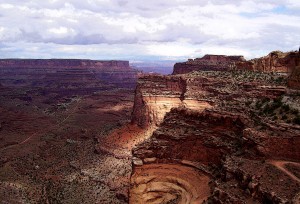
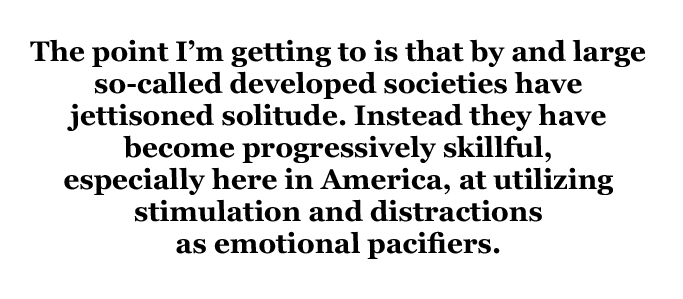
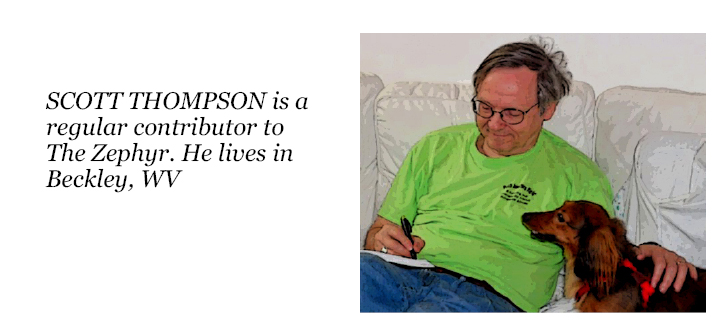
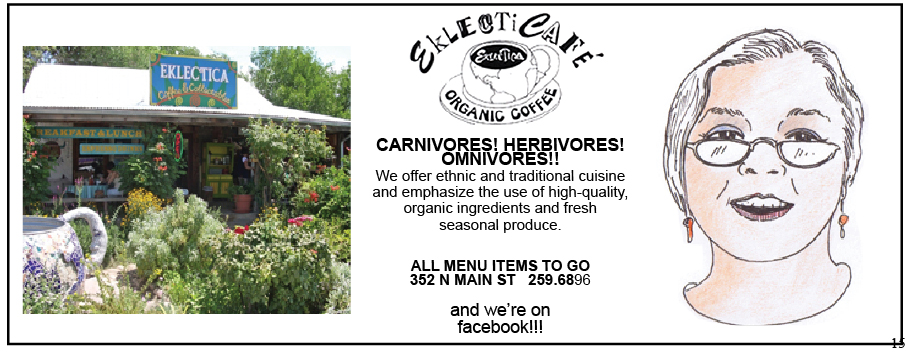
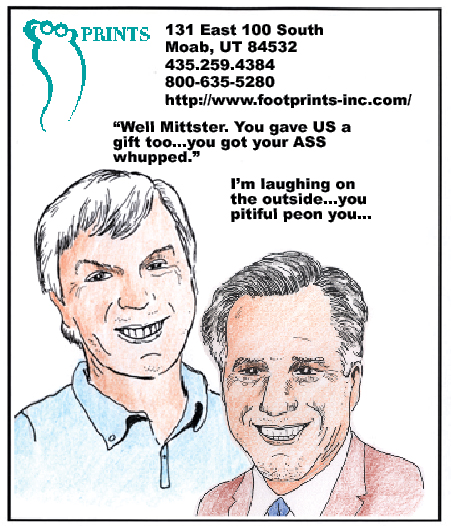


Mr. Thompson: I read with great interest your piece on the rapid decline of solitude and all its wonderful attributes. In my younger days,the seventies, I was fortunate to have lived in Flagstaff, AZ and worked for an icon of the region: Bill “The Breed” Breed, dept head of the geology/paleontology dept of the Museum of Northern Arizona. He introduced me to many of the then but now touristified places of the Four Corners Region: North Rim, GC, Canyon De Chelly, Oak Creek Canyon and the Sedona area as well as the slopes of the San Francisco peaks. Then one could drive to the area and in a short time slough off the stress of modern living for a few hours, days or weeks of rediscovering one’s inner self through the solitude of the place you were visiting. I have attempted to take my son to several of these places recently, only to find where access into the back country once depended on your skill in use of map and compass and ability to read the terrain, now has guided trails, groups of walking talking Ipod listening eco tourists with their GPS and no sense of wilderness ethics. This growth of tourism into what used to be pristine areas of solitude and wildness now have controlled access, rules and regulations, and even fees to enter. While i can understand the need for sharing and exposing beauty of place to the general public, I cannot understand why these same places have to become SO ACCESSIBLE. Sometimes one has to EARN their nature experience. The effort it took me to reach my wilderness goal also allowed my psychic to shake off the “cookies” brought about by daily living in a high tech society. Anyway, I ramble on. Thanks again for the article and may you always find that “wild place” where solitude is a friendly companion.
As somebody who has been lucky enough to live out his entire life within eyeshot of mountains, I am secretly in love with the high plains you describe…plenty of solitude and even de facto wilderness, albeit in a very altered state. Those National Grasslands are treasures though, and I hope soon to camp in one and catch a shortgrass prairie sunrise.
But the problem there is the lack of public land. A smattering of the aforementioned grasslands (set aside towards the end of the Dust Bowl I believe) but everything else belongs to somebody. HUGE OPEN SPACES, but you can’t pull over and camp or even go for a walk without instantly running into the no trespassing signs.
Which is why the mountain/desert west states are so epic, and so increasingly crowded. We all know that humanity needs freedom and a taste of the wild, and that’s exactly what is happening as beautiful places like Canyonlands become inundated with people. It’s a good thing in many ways, as folks can glimpse the void, smell the cowboy coffee, chase butterflies, or whatever metaphor you want to use, but this big awakening will certainly lead to more people visiting more of our favorite places.
My advice: take an airplane flight from one western city, say Denver, to another, say Phoenix, Salt Lake, or Boise. On the ground, you can see the human impact everywhere, and it gets depressing, at least for those of us with a bit of awareness or sense of natural history (as in the history of a specific landscape): barbed wire, invasive species, roads, mines, you name it. But from the air, from the precious window seat view (how can ANYONE in their right mind watch the in flight movie or sleep when they’ve got an airplane window seat???)the scale of the still mostly undeveloped and untrammeled wild west (notice I didn’t say “wilderness” or “pristine”)reveals itself in mind boggling clarity.
There are still huge spaces out there, even in the famous states like Utah and Colorado. It might not be postcard scenery or iconic views like the Tetons or Arches or Deadhorse Point–places full of people–and their may be cowshit and some ATV tracks and bullet shells here and there, but it will be big, and it will be empty, and you can easily lose yourself, or get lost, or get eaten by wild animals.
I have been to CanyonLands twice in my life. In May 1980 and exactly 20 years later. The second time we went into the canyon for 4days traveling the White Rim trail. There were other people here and there, I remember there was a group of bicycle riders testing their strength against the terrain. What impressed me the most was the staggering evidence of extreme time. It`s like a land that time has forgotten. Where all around you the geological record says welcome to eternity. It is a place where you can hear your own heart beating at rest. Where the ghosts of ancient people still wander and one must pay attention to not get lost because looking backwards you are apt to be mistaken and take a wrong turn retracing back to where you were. I know the absolute solitude is diminishing; so many people sharing the same space. But I think you have to keep it in perspective. It`s a far cry from say, China, where finding any solitude is truly a challenge.
What a great article. I’ve had this experience so often, when looking for epiphany in the place that’s supposed to generate epiphany. It rarely happens. It has to come upon you unexpectedly, in the place where you’re not looking for it. Happened to me strongly one year at Chaco Canyon — and the New Mexico landscape doesn’t generally do it for me the way northern Arizona/southern Utah does it for me, but that was a year when I felt absolutely nothing in Grand County. The poets know about this experience — of looking for epiphany and not finding it, or plucking the rose and “then the good minute goes”. Anyway, thanks for these musings, Scott. I want to re-post this.